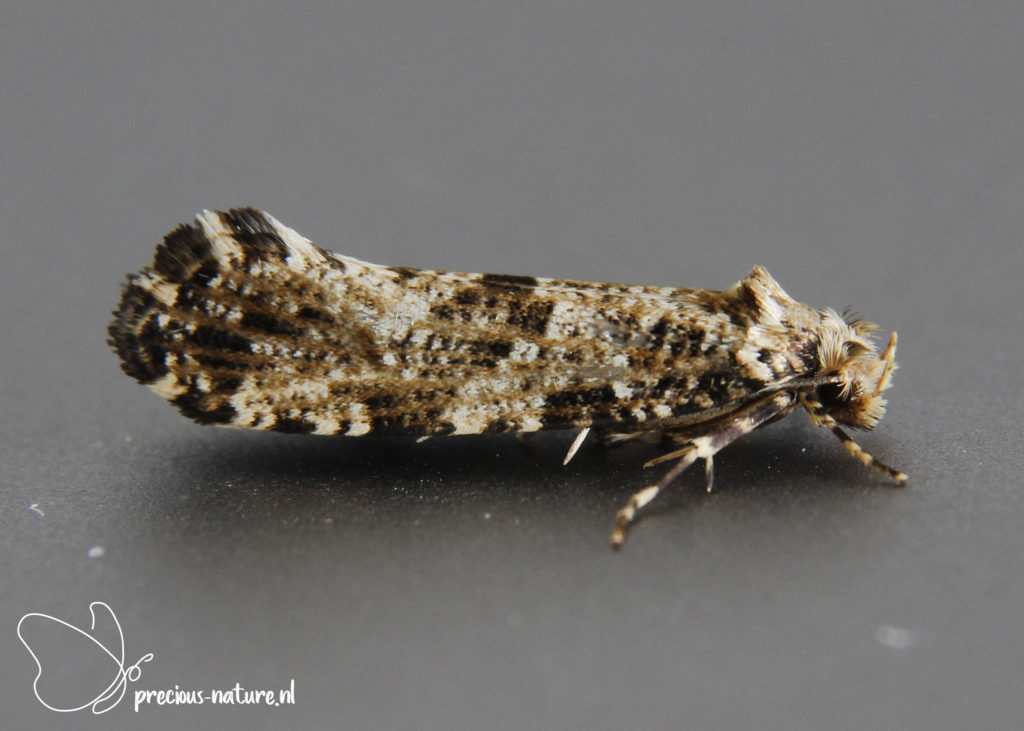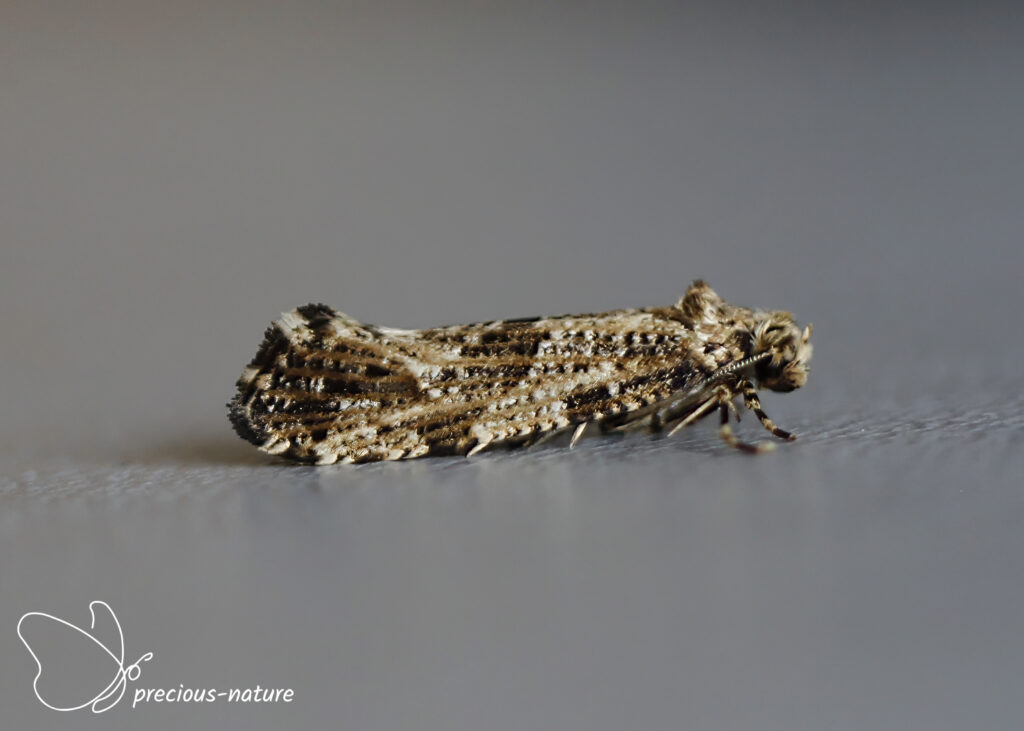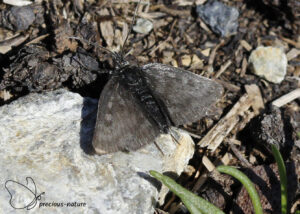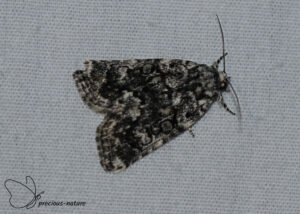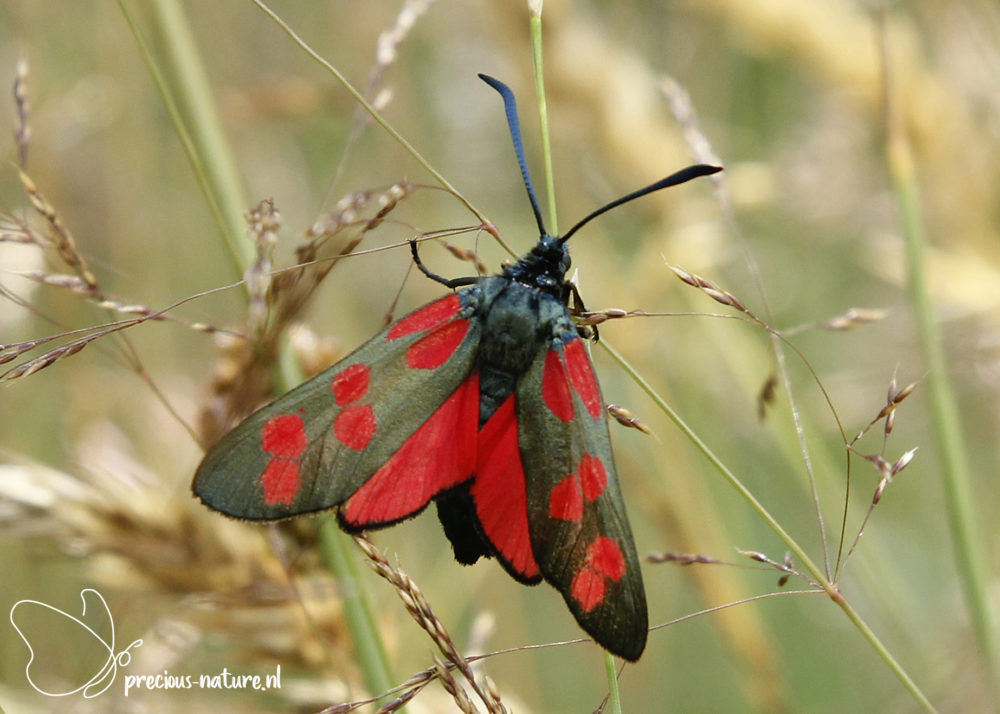The Clothes Moths (Tineidae) family, also called dust moths, includes about 60 different species. In the resting position, the wings are held in the “roof shape” at a fairly steep angle. The length of the forewing is very variable, 3-16 mm. The forewing often has a faint brown colour and sometimes has a specific pattern. The head is roughly hairy, and the antennae are often filamentous, about three-quarters of the length of the forewing.
Subfamily: Nemapogoninae
Genus: Nemapogon
Cork Moth – 2019 (NL)
(NCBI-index: 1.178132)
The Cork Moth (Nemapogon cloacella) is a striking moth that is well attracted to light during moth sessions. The head has yellow-orange hair, and the forewing is a mix of pale brown, reddish-brown, and whitish colours. This mix of colours has a striking white spot and some dark brown markings. The flying period spans two generations, from May to September, and the wingspan ranges from 10 to 18 mm. Host plant: Mosses and fungi. Dutch name: Gewoon kroeskopje. Frisian name: –
Flying period:

Subfamily: Scardiinae
Genus: Morophaga
Large Clothes Moth – 2021 (NL)
(NCBI-index: 1.870097)
The forewing of the Large Clothes Moth (Morophaga choragella) is sand-coloured, and the veins of the wing are striking, which are light brown. Various black-brown spots can be seen on the wing, especially along the leading edge and near the rear edge. The median line is recognisable, and the fringes are checkered in dark brown and white. The wingspan is 18-32 mm, and the flight period is one generation, from May to August. Host plant: Bracket fungi. Dutch name: Elfenbankjesmot. Frisian name: –
Flying period:
![]()
Subfamily: Tineinae
Genus: Tinea
Case-bearing Clothes Moth – 2024 (NL)
(NCBI-index: 41014)
Of the moths that impair animal materials and occur in homes and other buildings, the Case-bearing Clothes Moth (Tinea pellionella) is one of the best known. The head is orange to reddish brown. The forewing is pale grey-brown with 1 to 3 dark brown spots. The spot on 3/4 of the wing is usually the most conspicuous. The larvae feed on natural fibres with high keratin content, such as wool, fur and feathers. Although a link with bird nests was suspected, an extensive study of moths in bird nests did not confirm this. The flight period is two to three generations from April to October, and the wingspan is 9-16 mm. Host plant: wool, fur, feathers, hair, and sometimes stored vegetable products. Dutch name: Gewone pelsmot. Frisian name: –
Flying period:
![]()
Subfamily: Tineinae
Genus: Tinea
Triple-spotted Nest Moth – 2025 (NL)
(NCBI-index: 1.594354)
The Triple-spotted Nest Moth (Tinea trinotella) is easily distinguished from its relative, the Casebearing Clothes Moth (Tinea pellionella). The Triple-spotted Nest Moth is larger and lighter in colour, and the distinct black spot along the inner edge is particularly characteristic. The head has yellow hair, the forewing is yellow-grey with three black spots, and a thin black-brown stripe runs along the leading edge from the wing base to just beyond a third of the wing. The flight period is two generations, from late April to September, and the wingspan is 12-18 mm. Host plant: bird nests. Dutch name: Gele pelsmot. Frisian name: –
Flying period:



